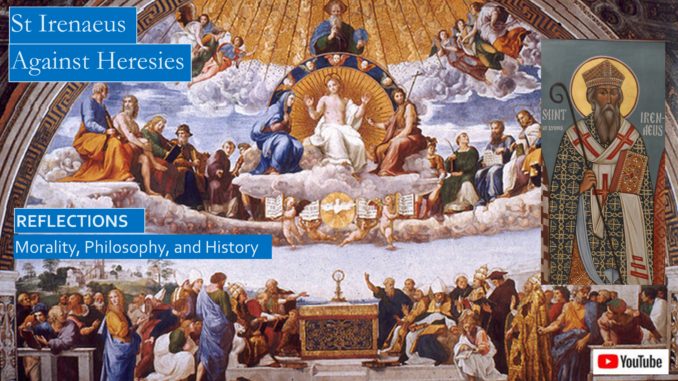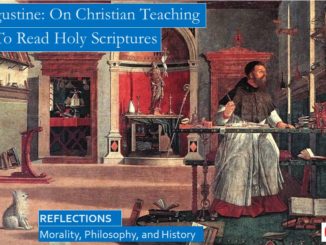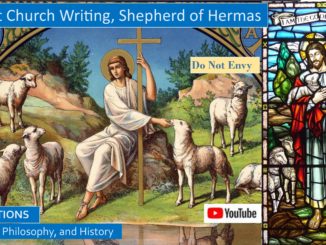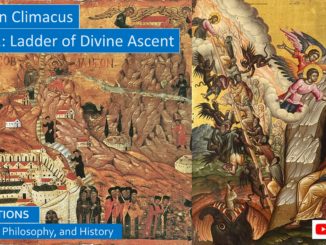
St Irenaeus is known for his work against the Christian heresies, especially the Gnostic heresies of Marcion and Valentinus. When confronting these heresies, St Irenaeus shapes the future course of Christian beliefs and theology.
Marcion called the Old Testament God the Demiurge, and said he was a punishing God, and that Jesus was the son of another more compassionate God. He also said that since Jesus was wholly divine that he really did not suffer in his earthly body, a common Gnostic heresy. To make the theology fit his Gnostic notions Marcion declared that the Old Testament books were not canonical, and he said the only legitimate gospel was a version of Luke he edited himself to fit his false teachings.[1] Valentinus developed a more full blown Gnostic system with Aeons and syzgies in multiples of magical numbers, he said that he and his followers had the secret knowledge to return to the divine Pleroma so they do not need to stay in the Kenoma,[2] which should not be confused with the Sharona.[3]
The best place to purchase the eBook version of the Ante-Nicene Fathers, Volume 1, is http://www.christianbook.com
See our additional introduction and further quotes from Eusebius, ancient Church historian, and modern historians on St Irenaeus:
http://www.seekingvirtueandwisdom.com/st-irenaeus-on-heresies-eusebius-and-modern-scholars-and-catholic-catechism/
Balthasar explores why Gnosticism was appealing to early Christians. They claimed they were the true authentic Christians, they saw themselves as the elite Christians. They were “craving for higher initiation and had an almost unbounded arrogance since they had moved from mere faith to a real, enlightened knowledge.” The Gnostics saw the world as flesh that would be vanquished while “the spiritual world was all that was excellent, the only thing worth cultivating. Sometimes extreme licentiousness was permitted or recommended, for after all ‘to the pure all things are pure’; at other times, the rule would be a god-hating ascetism.” We see these gnostic tendencies today in the fantastic Mormon cosmology and the intricate initiation rites of the Masons and Elks and other fraternal organizations.
How often do we hear of people who insist they are spiritual and not religious? Why would someone want to be spiritual and not religious? Perhaps they are put off by the hypocrisy of Christians behaving badly. More likely, they want to live according the rules of life they recognize, and don’t want anybody else or any God or tradition telling them how they should behave.
Balthasar notes that many early Church Fathers emphasized the Trinity so thoroughly that they unintentionally diminished the role of Christ, the Word, in salvation history. Balthasar writes, “the Son is said explicitly by Irenaeus to be GOD, and to evade the prying speculation of the Gnostics, he plunges the eternal generation of the Son from the Father in such deep mystery that there is no chance at all of it appearing as merely the first stage of the creation of the cosmos. Christ is God’s Word, the Self-Expression of the Father.”[4]
St Irenaeus teaches us, “The redemption depends on the real Incarnation, the real suffering on the Cross, and the real resurrection of the flesh. All three of these are a scandal for Gnosticism. On their view, Mary is not really Mother of God, and Christ did not really suffer, NO, the heavenly Christ escaped before the man Jesus suffered, and there can be no question at all of an actual resurrection of the flesh. Underlying this refusal of the flesh and its saving role in the Incarnation is a confusion between the human spirit (nous) and the divine Holy Spirit.” The Gnostics want to replace the Holy spirit with the human spirit. Irenaeus preaches “the salvific character of the Incarnation of God’s Son and Word.”[5]
St Irenaeus elaborates, “In times past it was SAID that man was made in the image of God, but not SHOWN, because the Word, in whose image man was made, was still invisible.” That is why this image dimmed over time. “But when the Word of God was made flesh, He confirmed that He was the true image of God, when He Himself became what His image was, and when He restored and made fast the likeness of God, making man like the invisible Father through the visible Word.”[6] In another book St Irenaeus teaches, “Just as those who see the light are in the light and share in its brightness, so those who see God are in God and receive His splendor. Now the splendor of God gives life; those who see God, therefore, receive life.”[7]
St Irenaeus also briefly mentions the heresy of the Ebionites. The Ebionites are Jewish Christians who typically deny the divinity of Christ. They recognize the Gospel of Matthew and repudiates St Paul and the other Gospels, including the Gospel of Luke and Acts, saying that St Paul was an “apostate from the law.”[8] When St Paul and the early Church Fathers warn us of the beliefs of the Judaizers, they are usually referring to the Ebionites.
In response to these heresies St Irenaeus drew up the first canonical list that was similar to today’s canon, including the four gospels and Acts, thirteen Pauline epistles, Revelation of John, and also the Shepherd of Hermas. He also includes reasons why the canon should only include the four gospels and the reason for the inclusion of the other books.
St Irenaeus also defends the authority of the books of the Old Testament. Chadwick tells us that St Irenaeus shows us “the manifest unity of the Old and New Testaments apparent in the fulfilment of ancient prophecy, stressing the parallelism between Adam and Christ which he found in Paul’s epistles.” St Irenaeus teaches that we can recover the innocent paradise of Adam through salvation, and since “he believed that in the Fall only the moral likeness to God was lost, not the basic image,” his Christian optimism contrasted to the dark pessimism of the Gnostics.[9]
Also, in response to the Gnostics, St Irenaeus explained the puzzle of Christ as God who descended to assume flesh and live as a man, while He was yet God, which was a puzzle to both Jews and Greeks. St Irenaeus teaches, “Christ became man to undergo temptation, and He was the Word that He might be glorified; the Word remaining quiescent, that He might be capable of being tempted, dishonored, crucified, and suffering death. His human nature was swallowed up in the Divine, when it conquered, and endured without yielding, performing acts of kindness, and was received up into Heaven.”[10] There are brackets indicating possible dropped words in the manuscript, and later Church Councils would improve on this formulation, but this shows that the early Church already had a mature view of Jesus as being both human and divine.
Likewise, St Irenaeus teaches us that “the knot of Eve’s disobedience was loosed by the obedience of Mary. For what the virgin Eve has bound fast through unbelief, this did the virgin Mary set free through faith.”[11]
St Irenaeus teaches us that there was but “one author of the Old and New Law,” and reminds us that Jesus teaches that the Law and the teachings of the prophets hinge upon the commands to Love God and to love our neighbor. Likewise, St Paul exhorts that there remain “faith, hope, and love, but the greatest of all is love.” St Irenaeus teaches that “love makes man perfect, and that he who Loves God is perfect, both in this world and in the world to come.”[12]
St Irenaeus tells us that he met and conversed with St Polycarp as a young man, the same Polycarp who was taught by the original apostle John. He also tells us that Peter was the first bishop of Rome, followed in the succession of bishops by Linus, then Clement who wrote the epistle bearing his name, listing the names of twelve bishops of Rome “who hold the inheritance of the episcopate,” a clear indication of apostolic succession through the bishops.[13] St Irenaeus teaches, “The truth is to be found nowhere else but in the Catholic Church, the sole repository of Apostolic Tradition.” The Church “is the entrance to life, all other (heresies) are thieves and robbers.”[14] “Where the Church is, there is the Spirit of God; and where the Spirit is, there is the Church, and every kind of grace, and the Spirit is truth.”[15]
READING ST IRENAEUS
Most of St Irenaeus’ main work “Against Heresies,” which he titled “The Detection and Refutation of False Knowledge,” survives in a few Latin translations, the Greek original survives only in fragments, and there are surviving sections in Syriac and Armenian. The translators complain constantly about the uncertain meaning of many passages, sometimes they have to imagine what the original Greek was to puzzle through its meaning. An Armenian translation of a second work, “Demonstration of the Apostolic Preaching,” was discovered in 1904. Irenaeus’ many other works have been lost in the sands of history.[16]
If you try to read St Irenaeus without any prior knowledge you may neither be encouraged or initially impressed. His work is not totally without error, in one place he claims Jesus was fifty when he died, and that his ministry lasted for ten years, which he said was the testimony of someone who conversed with an apostle.[17] His main work “Against Heresies” consists of five rather long and rambling books, you can skip through the first half that contains a very detailed summary of the heretical belief systems. Like St Justin Martyr’s writings, pay attention when you read teachings you may have heard many times, this may be the original teaching.
We highly recommend reading Balthasar’s Book on Irenaeus’ teachings, The Scandal of the Incarnation. He takes excerpts from the two extant works of Irenaeus, Against the Heresies and Demonstration of the Apostolic Preaching, arranged by topic, with a short discourse by Balthasar. Since St Irenaeus jumps around quite a bit, like many ancient authors, and since you will probably be skipping over big chunks as you pick out what you want to read, this is an invaluable source so you do not miss the best of St Irenaeus.
St Irenaeus Blog 2 http://www.seekingvirtueandwisdom.com/st-irenaeus-blog-2-against-heresies/
[1] https://en.wikipedia.org/wiki/Marcion_of_Sinope
[2] https://en.wikipedia.org/wiki/Valentinus_(Gnostic)
[3] https://www.youtube.com/watch?v=g1T71PGd-J0
[4] Hans Urs von Balthasar, “The Scandal of the Incarnation, Irenaeus Against the Heresies,” translated by John Saward (San Francisco, Ignatius Press, 1990), p. 17.
[5] Balthasar, “The Scandal of the Incarnation, Irenaeus Against the Heresies,” pp. 1-2.
[6] Irenaeus, “Irenaeus Against Heresies,” in “The Scandal of the Incarnation,” Chapter 5, Book 6, p. 56.
[7] Irenaeus, “Irenaeus Against Heresies,” in “The Scandal of the Incarnation,” Chapter 4, Book 120, p. 111.
[8] Irenaeus, “Irenaeus Against Heresies,” in the Nicene and Post-Nicene Fathers, First Series, Volume 1 (Boston: Hendrickson Publishers, 1994, first published 1885), Book 1, Chapter 27, p. 352.
[9] Henry Chadwick, “Justin and Irenaeus,” in The Early Church (New York: Dorset Press, 1967), pp.80-82.
[10] Irenaeus, “Irenaeus Against Heresies,” Book 3, Chapter 19, p. 449.
[11] Irenaeus, “Irenaeus Against Heresies,” Book 3, Chapter 22, p. 455.
[12] Irenaeus, “Irenaeus Against Heresies,” Book 4, Chapter 12, p. 476.
[13] Irenaeus, “Irenaeus Against Heresies,” Book 3, Chapter 3, pp. 415-416.
[14] Irenaeus, “Irenaeus Against Heresies,” Book 3, Chapter 4, pp. 416-417.
[15] Irenaeus, “Irenaeus Against Heresies,” Book 3, Chapter 24, p. 459.
[16] Edgar Goodspeed, revised and enlarged by Robert Grant, “A History of Early Christian Literature” (Chicago: University of Chicago Press, 1942, 1966), pp. 120-122.
[17] Irenaeus, “Irenaeus Against Heresies,” Book 2, Chapter 22.6, p. 392, and footnote 2, p. 392.




3 Trackbacks / Pingbacks